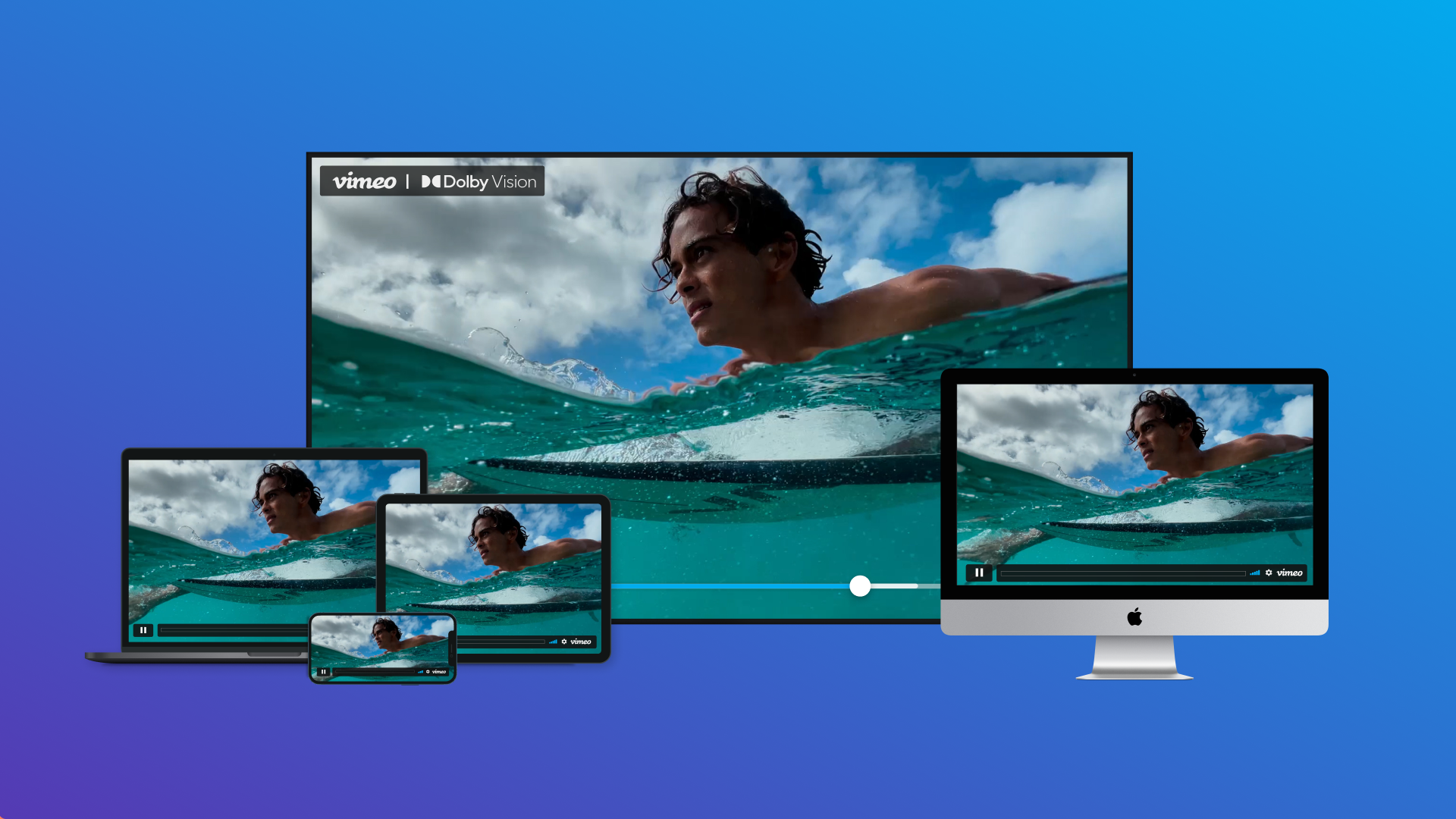Want to uplevel your video quality with better brightness and richer colors to tell lifelike stories?
With Dolby Vision, you can easily shoot and create cinema-grade videos directly on your iPhone 12 or later and host them on Vimeo where viewers can enjoy them in all their glory.
Hard to believe? Let’s show you how in this post alongside a rundown of what Dolby Vision is, how to enable it on your iPhone 12 or later, and the new hosting capabilities on Vimeo.
Dolby Vision: What it is and why it’s the future of iPhone video and beyond
Dolby Vision is an HDR technology trusted by storytellers across the board for its ability to accurately deliver incredible color, brightness, and detail to billions of playback devices.
With your iPhone 12 or later, you can easily capture and share cinematic video content – thanks to the new ability to host Dolby Vision video on Vimeo’s platform.
As you’ll learn in this post, Vimeo supports Dolby Vision video quality for Apple users.
Let’s start with the basics.
What is High Dynamic Range (HDR)?
High Dynamic Range (HDR) is a video technology that captures a wider color range and luminosity than standard dynamic range (SDR) tech.
This results in ultra-vivid pictures, brighter highlights, darker shadows, and incredible color.All in all - who wouldn’t want to use HDR to film videos?
What is Dolby Vision?
Dolby Vision is a technology created by Dolby Laboratories for producing, distributing, and playing back high dynamic range (HDR) videos – highly detailed videos with extraordinary brightness, color, contrast, and detail.
The special sauce? Dolby Vision leverages dynamic metadata and it’s end-to-end playback ecosystem to automatically adjust the color and brightness of each scene of your video to best match the capabilities of any given Dolby Vision enabled playback device.
Ultimately, it helps you deliver your content to viewers with your creative intent intact to improve the viewing experience and connect better with your audience by telling impactful, more cinematic stories.
Dolby Vision on the iPhone 12 or later
Dolby Vision has been a leading standard for Hollywood movies and high-production TV for the better part of a decade, and this has led to Dolby Vision playback being widely available across various types of consumer devices, from TVs to smartphones.
Starting with the iPhone 12, anyone can now easily create content in Dolby Vision – giving millions of everyday creators access to Hollywood level technology that can be viewed on billions of devices that support Dolby Vision.
How to enable Dolby Vision on iPhone 12 or later
Excited to record Hollywood-quality videos? Awesome 🙌
Grab your iPhone 12 or later and start shooting. That's it! Dolby Vision recording is enabled by default. To check if Dolby Vision is enabled, follow these steps:
1. Head to Settings in your iPhone
2. Scroll down until you reach the Camera settings option.
3. Click Record Video.
4. Ensure the HDR Video option is enabled.
In case you want to deactivate the option to capture videos in Dolby Vision, follow the same steps and toggle off the HDR Video option.Now start shooting engaging video guides, instructional videos, video ads, educational videos, and more.
What video platforms and devices support Dolby Vision playback?
Of all the prominent video-sharing platforms, Vimeo is the first all-in-one global video platform that supports Dolby Vision, allowing for hosting, sharing, and playback of videos created in Dolby Vision on Apple devices.
In order to view your HDR videos in Dolby Vision on Vimeo, viewers must be using a compatible Apple device, which includes the iPhone 8 or later, Apple TV 4K, Mac, and 2nd generation iPad Pro or later.
By hosting and sharing videos with Vimeo, you can retain the creative awesomeness of your Dolby Vision video quality and deliver an incredible viewing experience to your audiences watching from supported Apple devices.
HDR10 vs Dolby Vision: what’s the difference?
Another HDR specification that you might have heard of is HDR10.
The question then is: how do the two HDR technologies differ?
Briefly, HDR10 uses static metadata to display visuals, and has limited abilities when it comes to playback optimization. On the other hand, Dolby Vision is a technology that uses dynamic metadata - plus an end-to-end ecosystem of content creation tools, distribution, and playback technology - to deliver a better quality and more consistent viewing experience on any supported playback device. Let’s dig into the difference:
Dolby Vision uses dynamic metadata vs. HDR10’s static metadata
Static metadata is basic compared to its dynamic variant. Put simply, HDR10 uses the same brightness and color metadata for the entire film – limiting how accurately your creative intent can be delivered to viewers.
With Dolby Vision and dynamic metadata, you’re able to deliver your original content to viewers with much more accuracy. Dynamic metadata carries frame-by-frame instructions that tell a Dolby Vision compatible device precisely how to recreate brightness and color - optimizing playback of your content to the capabilities of the display, and in some cases even to the lighting conditions of the playback environment.
Naturally, this translates to better quality video experiences for your viewers, and let’s them experience your HDR video content the way you intended.
Experience Dolby Vision on Vimeo
Enhance your content before it hits the video player. Leverage editing tools like the trimmer, merging tool, compressor, and GIF creation feature.
 Masooma Memon</a> is a freelance writer for SaaS and lover of to-do lists. When she's not writing, she usually has her head buried in a business book or fantasy novel. Connect with her on <a href=https://vimeo.com/blog/post/"https://twitter.com/inkandcopy">Twitter.
Masooma is a contributing writer. Vimeo commissions pieces from a variety of experts to provide a range of insights to our readers, and the views and opinions expressed here are solely those of the author. All content and any external links are provided for informational purposes only." title="<a href=https://vimeo.com/blog/post/"https://inkandcopy.com/">Masooma Memon</a> is a freelance writer for SaaS and lover of to-do lists. When she's not writing, she usually has her head buried in a business book or fantasy novel. Connect with her on <a href=https://vimeo.com/blog/post/"https://twitter.com/inkandcopy">Twitter.
Masooma is a contributing writer. Vimeo commissions pieces from a variety of experts to provide a range of insights to our readers, and the views and opinions expressed here are solely those of the author. All content and any external links are provided for informational purposes only." width="115" height="65" aria-hidden="false" class="progressive-image object-cover rounded-lg md:rounded-3xl w-[75px] h-[50px] md:w-[115px] md:h-[65px] bg-image-background transform-gpu will-change-[object-position]"/>
Masooma Memon</a> is a freelance writer for SaaS and lover of to-do lists. When she's not writing, she usually has her head buried in a business book or fantasy novel. Connect with her on <a href=https://vimeo.com/blog/post/"https://twitter.com/inkandcopy">Twitter.
Masooma is a contributing writer. Vimeo commissions pieces from a variety of experts to provide a range of insights to our readers, and the views and opinions expressed here are solely those of the author. All content and any external links are provided for informational purposes only." title="<a href=https://vimeo.com/blog/post/"https://inkandcopy.com/">Masooma Memon</a> is a freelance writer for SaaS and lover of to-do lists. When she's not writing, she usually has her head buried in a business book or fantasy novel. Connect with her on <a href=https://vimeo.com/blog/post/"https://twitter.com/inkandcopy">Twitter.
Masooma is a contributing writer. Vimeo commissions pieces from a variety of experts to provide a range of insights to our readers, and the views and opinions expressed here are solely those of the author. All content and any external links are provided for informational purposes only." width="115" height="65" aria-hidden="false" class="progressive-image object-cover rounded-lg md:rounded-3xl w-[75px] h-[50px] md:w-[115px] md:h-[65px] bg-image-background transform-gpu will-change-[object-position]"/>